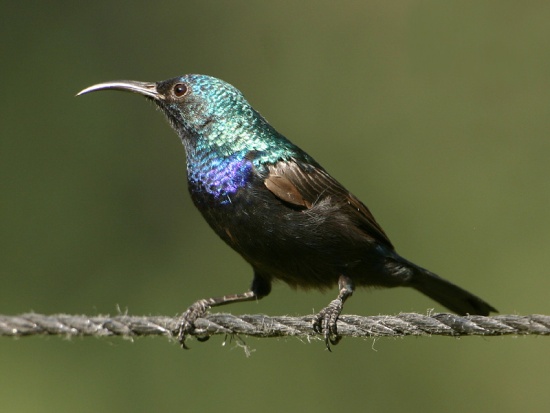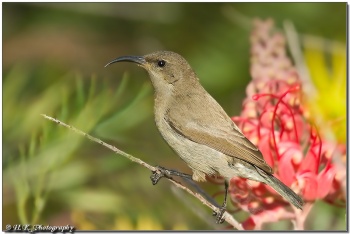(genus link) |
(→External Links: Corrected category spelling) |
||
| (6 intermediate revisions by 2 users not shown) | |||
| Line 1: | Line 1: | ||
| − | [[ | + | [[Image:Palestine_Sunbird.jpg|thumb|550px|right|Photo by {{user|rony_roshtov|rony_roshtov}} <br />Jerusalem, [[Israel]], August 2004]] |
;[[:Category:Cinnyris|Cinnyris]] osea | ;[[:Category:Cinnyris|Cinnyris]] osea | ||
''Nectarinia osea'' | ''Nectarinia osea'' | ||
| − | |||
| − | |||
==Identification== | ==Identification== | ||
| − | 8 to 12 cm | + | 8 to 12 cm |
| − | + | *Black, downward curving, long bill | |
| − | + | *Orange tufts to the side of the chest from November to June (usually hidden by the closed wing) | |
| + | Females and juveniles are grey brown above, pale underparts. | ||
==Distribution== | ==Distribution== | ||
| − | [[Africa]] | + | [[Image:IMG 9127s.jpg|thumb|350px|right|Male showing chest tufts <br />Photo by {{user|mikiort|mikiort}}<br />Central [[Israel]], May 2014]] |
| − | + | [[Africa]] and the [[Middle East]]:<br /> | |
| + | '''Northern Africa''': occurs only in [[Egypt]]<br /> | ||
| + | '''Western Africa''': [[Chad]], [[Cameroon]], [[Central African Republic]], [[Equatorial Guinea]] and [[Democratic Republic of Congo]]<br /> | ||
| + | '''Eastern Africa''': [[Sudan]], [[South Sudan]] and [[Uganda]]<br /> | ||
| + | '''Middle East''': [[Syria]], [[Lebanon]], [[Israel]], [[Jordan]], [[Arabian Peninsula]], [[Saudi Arabia]] and [[Yemen]] | ||
==Taxonomy== | ==Taxonomy== | ||
| − | This is one of the many Sunbirds that have recently been moved to the genus ''Cinnyris'' from the genus ''Nectarinia''. | + | This is one of the many Sunbirds that have recently been moved to the genus ''Cinnyris'' from the genus ''[[:Category:Nectarinia|Nectarinia]]''. |
| − | + | ====Subspecies==== | |
| − | There are two subspecies: '' | + | [[Image:IMGP4372b.jpg|thumb|350px|right|Female<br />Photo by {{user|CannonS2|CannonS2}}<br />Israel, 2009]] |
| − | + | There are two subspecies<sup>[[#References|[1]]]</sup>: | |
| + | *''C. o. decorsei'': | ||
| + | :*Very patchily distributed in eastern [[Cameroon]], southwestern [[Chad]] (Lake Chad), [[Central African Republic]], southwestern [[Sudan]], extreme northeastern [[Democratic Republic of the Congo]], southwestern [[South Sudan]], and northwestern [[Uganda]] | ||
| + | *''C. o. osea'': | ||
| + | :*[[Syria]], [[Israel]] to [[Turkey]] and [[Arabia]] (east to [[Oman]]) | ||
==Habitat== | ==Habitat== | ||
Dry woodland, scrub, wadis, savannas, orchards and gardens and is common in towns in some areas. | Dry woodland, scrub, wadis, savannas, orchards and gardens and is common in towns in some areas. | ||
| − | |||
==Behaviour== | ==Behaviour== | ||
| − | The diet consists mainly of insects | + | ====Diet==== |
| − | + | The diet consists mainly of nectar, spiders and insects. The long tongue extracts the nectar whilst the bird is perched or hovering. | |
| + | [[Image:NI1 9575.jpg|thumb|350px|right|Photo by {{user|nissim|nissim}}<br />[[Israel]], 2009]] | ||
| + | Where-ever there are suitable honey producing plants you can find these lively little birds, sometimes quite a few together, though they are normally very aggressive and territorial during the breeding season. | ||
| + | ====Breeding==== | ||
The nest is made of grass, leaves and plant material held together with spiders' webs and hair, lined with feathers and wool, and is suspended from a branch. 1-3 eggs are laid, which are incubated for 13-14 days. The young fledge after 14 to 21 days. | The nest is made of grass, leaves and plant material held together with spiders' webs and hair, lined with feathers and wool, and is suspended from a branch. 1-3 eggs are laid, which are incubated for 13-14 days. The young fledge after 14 to 21 days. | ||
| − | + | ====Vocalisation==== | |
| + | '''Song''': a high, fast, jingle ''chwing-chwing-chweing''<br /> | ||
| + | '''Call''': they have a variety of calls including a harsh alarm call. | ||
==References== | ==References== | ||
| − | + | #{{Ref-Clements6thAug17}}#Avibase | |
| + | #Handbook of the Birds of the World Alive (retrieved May 2014) | ||
| + | #BF Member observations | ||
| + | #The Handbook of Bird Identification: For Europe and the Western Palearctic, By Mark Beaman, Steve Madge | ||
| + | #Wikipedia | ||
| + | {{ref}} | ||
| + | ==External Links== | ||
| + | {{GSearch|"Cinnyris osea" {{!}} "Nectarinia osea" {{!}} "Palestine Sunbird"}} | ||
| + | <br /> | ||
| + | {{VSearch|"Cinnyris osea" {{!}} "Nectarinia osea" {{!}} "Palestine Sunbird"}} | ||
| + | {{GS-checked}}1 | ||
| + | <br /> | ||
| + | <br /> | ||
| − | + | [[Category:Birds]] [[Category:Cinnyris]] [[Category:Videos]] | |
| − | |||
| − | [[Category:Birds]] | ||
Latest revision as of 19:32, 9 October 2023
- Cinnyris osea
Nectarinia osea
Identification
8 to 12 cm
- Black, downward curving, long bill
- Orange tufts to the side of the chest from November to June (usually hidden by the closed wing)
Females and juveniles are grey brown above, pale underparts.
Distribution
Africa and the Middle East:
Northern Africa: occurs only in Egypt
Western Africa: Chad, Cameroon, Central African Republic, Equatorial Guinea and Democratic Republic of Congo
Eastern Africa: Sudan, South Sudan and Uganda
Middle East: Syria, Lebanon, Israel, Jordan, Arabian Peninsula, Saudi Arabia and Yemen
Taxonomy
This is one of the many Sunbirds that have recently been moved to the genus Cinnyris from the genus Nectarinia.
Subspecies
There are two subspecies[1]:
- C. o. decorsei:
- Very patchily distributed in eastern Cameroon, southwestern Chad (Lake Chad), Central African Republic, southwestern Sudan, extreme northeastern Democratic Republic of the Congo, southwestern South Sudan, and northwestern Uganda
- C. o. osea:
Habitat
Dry woodland, scrub, wadis, savannas, orchards and gardens and is common in towns in some areas.
Behaviour
Diet
The diet consists mainly of nectar, spiders and insects. The long tongue extracts the nectar whilst the bird is perched or hovering.
Where-ever there are suitable honey producing plants you can find these lively little birds, sometimes quite a few together, though they are normally very aggressive and territorial during the breeding season.
Breeding
The nest is made of grass, leaves and plant material held together with spiders' webs and hair, lined with feathers and wool, and is suspended from a branch. 1-3 eggs are laid, which are incubated for 13-14 days. The young fledge after 14 to 21 days.
Vocalisation
Song: a high, fast, jingle chwing-chwing-chweing
Call: they have a variety of calls including a harsh alarm call.
References
- Clements, J. F., T. S. Schulenberg, M. J. Iliff, D. Roberson, T. A. Fredericks, B. L. Sullivan, and C. L. Wood. 2017. The eBird/Clements checklist of birds of the world: v2017, with updates to August 2017. Downloaded from http://www.birds.cornell.edu/clementschecklist/download/
- Avibase
- Handbook of the Birds of the World Alive (retrieved May 2014)
- BF Member observations
- The Handbook of Bird Identification: For Europe and the Western Palearctic, By Mark Beaman, Steve Madge
- Wikipedia
Recommended Citation
- BirdForum Opus contributors. (2025) Palestine Sunbird. In: BirdForum, the forum for wild birds and birding. Retrieved 26 April 2025 from https://www.birdforum.net/opus/Palestine_Sunbird
External Links
GSearch checked for 2020 platform.1







